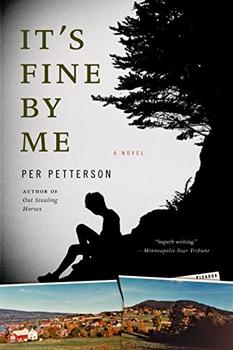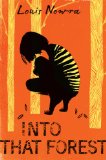Summary | Excerpt | Reviews | Beyond the book | Read-Alikes | Genres & Themes | Author Bio

Books are like meals for me; some are light and tasty, but eventually I hunger for something more substantial. Others are "stick-to-your-ribs;" you feel satisfied afterward, and you remember it for a long time. Janne Teller's Nothing is a full meal deal. I have not been able to stop talking about it since I read it (twice) before writing this review. Nothing is ready-made for book club or classroom discussions, and it's guaranteed to provide (forgive me) food for thought long after you have finished reading.
The story centers on a group of 13 and 14 year old classmates struggling with what to do when one of them, Pierre, suddenly declares that "life is meaningless," and promptly climbs a plum tree. From there, he spends his days mocking his friends for their insistence on participating in the world in the face of its meaninglessness, and their inevitable demise. His stance, at first, seems nihilistic (see Sidebar). However, a nihilist does not withdraw from the world and shout his beliefs from the treetops, nor does he care whether or not he can convert others to his philosophy. Pierre's acts belie nihilistic intent, and show that he does care. When he petulantly throws plums at the children and claims that they're hitting their marks by chance (because aiming "wasn't worth it"), it seems disingenuous. When he tells Agnes, the narrator, that she will discover her life to be meaningless when she is an adult because, "you'll find out you're a clown in a trivial circus," it comes across as a lament. Pierre wants the world to be different than what he perceives. Unlike a traditional nihilist, he is not bent on self-destruction, or outward violence toward those who disagree with him. He wants to find meaning and value, but he doesn't quite believe it to be possible.
Nevertheless, Pierre's friends find his actions very disturbing, not least because they secretly fear that he might be right. Desperate and frustrated, the children hit upon the idea of building a collection of objects that are personally meaningful to each of them, in the hope that Pierre will look at it and realize that there is meaning, and come back into their world.
At this point, the story takes a critical turn, going from fanciful fable to dark realism. Shortly into the project, the children recognize that none of them has the fortitude to truthfully name and give up, perhaps permanently, their most beloved possession. So a fateful decision is made: each child will choose the item that another child must give up, and there can be no arguments, no deals. As each child tearfully parts with something he or she prizes, resentment and anger begin to build, with no outlet except the power to take it out on the next one in line.
The children's heap of meaning may be the most important "character" in the book, made up as it is of the things that give value to their world. It is so unique that when news about it is released to the media, it gains status as a work of art. The implications of this new "aesthetic" value for the heap's meaning, or lack thereof, can make for some wonderful discussion, especially in light of Pierre's angry comment that, "If that pile of garbage meant anything at all, it stopped the day you sold it for money."
Nothing delves deep into philosophical territory in a way that few modern fiction novels (especially YA novels) do. Within this tale we find themes of nihilism and existentialism, materialism, and fear of nonconformity. Teller makes us think about how we are able to face the reality of death, and still manage to find meaning in life (whether one is religious or not). Most importantly, the novel asks: what creates "meaning?" I'll warn you that it doesn't answer all of these questions, but this is a good thing for thoughtful readers.
I wish that I could say so much more about this novel. It is a simple tale on the surface, but one with many extraordinary layers.
Age recommendation: Nothing is marketed as a Young Adult book (12 and up). The philosophical dimensions of the story might be over the heads of some young readers, and the novel contains episodes of intense violence that could be upsetting for any age. Still, I would consider it a wonderful choice for high school students, and possibly for mature-minded middle school readers. It would present an excellent opportunity for a multi-faceted discussion in classrooms, or at home.
![]() This review was originally published in The BookBrowse Review in March 2010, and has been updated for the
April 2012 edition.
Click here to go to this issue.
This review was originally published in The BookBrowse Review in March 2010, and has been updated for the
April 2012 edition.
Click here to go to this issue.

If you liked Nothing, try these:

by Per Petterson
Published 2013
Sometimes tender, sometimes brutal, It's Fine By Me is a brilliant novel from the acclaimed author of Out Stealing Horses and I Curse the River of Time.

by Louis Nowra
Published 2013
Two girls survive a terrible flood in the Tasmanian bush and are rescued by a pair of Tasmanian tigers who raise them in the wild. Totally believable, their story will both shock and captivate readers as it explores the animal instincts that lie beneath our civilized veneer and celebrates the ways of the tiger.
Wherever they burn books, in the end will also burn human beings.
Click Here to find out who said this, as well as discovering other famous literary quotes!
Your guide toexceptional books
BookBrowse seeks out and recommends the best in contemporary fiction and nonfiction—books that not only engage and entertain but also deepen our understanding of ourselves and the world around us.